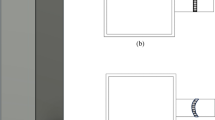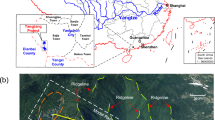Abstract
Longwall Top Coal Caving (LTCC), a relatively newer technology in India, is an underground mining method developed for thick seam extraction. Various factors and systematic approaches are to be considered and properly evaluated in order to qualify and gain confidence in the assessment of introducing LTCC mining method. The proposed paper presents the various processes involved in designing a LTCC technology in one of the mine sites at Singareni Coal Company Limited (SCCL), India. The project undertook a comprehensive analysis of geological and geophysical data of the mine site and developed detailed geotechnical frameworks for the assessment of LTCC technology.
Similar content being viewed by others
References
Peng, S.S. and Chiang, H.S., Longwall Mining, New York: Wiley, 1983.
Cai, Y., Hebblewhite, B.K., Onder, U., Xu, B., Kelly, M., Wright, B., and Kraemer, M., Application of Longwall Top Coal Caving to Australian Operations, CSIRO-ACARP Report C11040, 2003.
Xie, H., Chen, Z., and Wang, J., Three Dimensional Numerical Analysis of Deformation and Failure during Top Coal Caving, International Journal of Rock Mechanics and Mining Sciences, 1999, vol. 36, pp. 551–558.
Khanal, M., Adhikary, D., and Balusu, R., Evaluation of Mine Scale Longwall Top Coal Caving Parameters Using Continuum Analysis, Mining Science and Technology (China), 2011, vol. 21, no. 6, pp. 787–796.
Balusu, R., Adhikary, D., Khanal, M., Zhou, B., Poulsen, B., Sliwa, R., and Karekal, S., APP Report: Thick Coal Seam Extraction, APP—Coal Mining Task Force, Department of Resources, Energy and Tourism, 2012.
MeSy (India) Pvt. Ltd., In-Situ Stress and Permeability Measurements in Boreholes in the KTK.3 Incline Dipside Block and in the KTK. Longwall Block of Bhupalpalli Area of the Mulug Coal Belt of Warangal District, Andra Pradesh, Report no. SCCL_01/08, 2008.
NIRM, Investigation into In Situ Strength of Coal at GDK-10A Incline and GDK-10 Incline, RG-III Area, SCCL. NIRM Project No. GC-08-01-c, April, 2008.
Medhurst, T., Estimation of the In Situ Strength and Deformability of Coal for Engineering Design, PhD Thesis, University of Queensland, Australia, 1996.
SCCL, Draft PIB Note of Adriyala Shaft Project, Ramagundam Region, Internal Report, 2006.
Hoek, E. and Brown, E.T., Underground Excavations in Rock. The institution of Mining and Metallurgy, London, 1982.
McNally, G.H., The prediction of Geotechnical Rock Properties from Sonic and Neutron, Logs: Exploration Geophysics, 1990, vol. 21, pp. 65–71.
Zhong, M.J., Theory and Technology of Top Coal Caving Mining, China Coal Industry Publishing House, 2001.
Humphreys, P. and Poulsen, B., BMA-Geological Assessment and Numerical Modeling of LTCC, CSIRO Report, 2008.
Cosserat, E. and Cosserat, F., Theorie des corps deformables, Paris: Hermann, 1909.
Author information
Authors and Affiliations
Corresponding author
Additional information
The article is published in the original.
Rights and permissions
About this article
Cite this article
Khanal, M., Adhikary, D. & Balusu, R. Prefeasibility study—Geotechnical studies for introducing longwall top coal caving in Indian mines. J Min Sci 50, 719–732 (2014). https://doi.org/10.1134/S1062739114040139
Received:
Published:
Issue Date:
DOI: https://doi.org/10.1134/S1062739114040139




